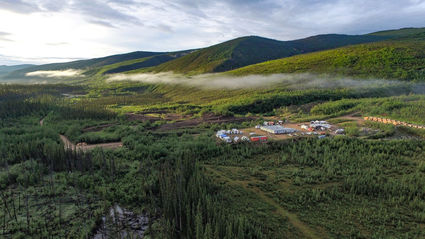Junior plans to drill deep for answers
Triumph Gold will look 1,600m beneath Freegold Mountain North of 60 Mining News – June 1, 2019
Last updated 9/25/2020 at 4:49pm

Triumph Gold Corp.
Triumph Gold's Freegold Mountain property enjoys the advantages of a well-established camp in a road-accessible and mineral-rich area of the Yukon.
Triumph Gold Corp. is making significant, new strides toward unlocking the geological secrets of Freegold Mountain, a district-scale property that could produce one of the richest copper-gold resources yet discovered in the Yukon. The Canadian and Yukon governments, meanwhile, are moving forward with a joint effort to spur mine development in the Dawson Range where the Freegold Mountain project is located along with many others, including the Casino copper-gold and Coffee Gold projects, which both aim to begin production in 2021.
Prospectors have pulled knobby chunks of placer gold from creeks that flow across Freegold Mountain since the early days of the 20th century, and discoveries of hardrock mineral deposits on the property date back to the 1950s. But Freegold Mountain still hugs close perhaps its biggest secret, the underlying source of the various copper, gold and base metal deposits discovered on the mountain over the years.
For decades, Triumph Gold – formerly Northern Freegold Ltd. – and earlier explorers searched the 202 square kilometers (78 square miles) of contiguous claims and found showings of both precious and base minerals. But each new discovery seems to raise just as many questions as it answered. Since Triumph Gold acquired the property in 2006, more than 20 mineralized zones have been identified.
The junior also reported NI 43-101 resources in December 2014 for three of the largest deposits, Nucleus, Revenue and Tinta Hill.
Triumph geologists believe emerging geological evidence from the six-kilometer (3.7 miles) area encompassing Revenue and Nucleus to the west overwhelmingly supports a massive, evolving hydrothermal system on Freegold Mountain. They say characteristics of the Revenue and Nucleus hydrothermal systems are typical of gold-copper porphyry mineralization, which is the primary source of the world's gold and copper production.
A resource estimate for the Nucleus deposit includes indicated resources of 1.3 million ounces gold; 2.2 million oz silver and 105 million pounds copper in 75 million metric tons of ore with a gold-equivalent cutoff grade of 0.3 grams per metric ton; and an inferred resource of 800,000 oz gold; 3.15 million oz silver, and 69.16 million lbs copper in 64 million tons of ore at the same cutoff grade.
An inferred resource for Revenue includes some 1 million oz gold, 9 million oz silver, 241.4 million pounds copper and 82,800 lbs molybdenum in 80.8 million metric tons of ore with a gold-equivalent cutoff grade of 0.5 g/t.
Near the eastern corner of the property roughly 10 kilometer (six miles) from the Nucleus-Revenue anomaly, the Tinta Hill deposit also has a 2014 inferred resource estimate of 131,000 oz gold; 3.8 million oz silver, 13 million pounds copper, 47.1 million lbs lead and 67.2 million lbs zinc in 2.2 million metric tons of ore with a gold cutoff grade of 0.5 g/t. Tinta Hill is an intrusion-hosted copper-gold-enriched polymetallic vein-type deposit.
Freegold Mountain also encompasses other copper-gold porphyry exploration targets, including the Stoddart, Cabin, Nitro, and Castle zones. Outboard of the porphyry targets are a number of gold-rich epithermal vein showings, including Irene, Ridge, Goldy and Dart, and gold-rich skarn showings as well. These showings, along with more than a dozen others on the property, are at various stages of exploration.
Goldcorp investment
Rather than continuing to build ounces at the existing deposits in 2016, Triumph Gold decided to view the Freegold Mountain project as a greenfields property by evaluating many other targets and aggressively exploring them.
A compilation of historical soil geochemistry exposed the six-kilometer (3.7 miles) long gold and copper anomaly that encompasses the Nucleus and Revenue deposits.
Describing the Revenue-Nucleus anomaly as one of the largest and most intense soil anomalies in western North America, Triumph Gold Vice President of Exploration Tony Barresi, Ph.D. said recent discoveries in the area prove the anomaly is in-situ; not a result of leakage or dispersion.
He points to much-younger rocks in the anomaly being surrounded by considerably older rocks as evidence that a very large causative intrusion lies beneath the various mineralized deposits discovered in the area.
Company geologists believe the entire soil anomaly is underlain by rocks affected by a gold-rich hydrothermal system related to a large porphyry intrusion buried some 500 – 600 meters deep that is yet to be tested by drilling.
"Because it's so distant, it has created different types of mineralization in a condensed area," Barresi told Mining News May 27.
Impressed by Triumph Gold's new perspective on the project, Goldcorp purchased a 20 percent stake in the company for C$6.3 million. With these funds, the junior mounted aggressive exploration campaigns in 2017 and 2018 that paid off with more encouraging discoveries.
Using a step-out drilling strategy, geologists identified high-temperature, porphyry-style mineralization beyond the limits of the known resource within the Revenue-Nucleus soil anomaly and generated new targets.
In 2017, Triumph Gold intersected the WAu Breccia, mineralization it defined a year later as a high-grade, copper-gold-silver-molybdenum-tungsten bearing tabular breccia body, with semi-massive sulphides that is at least 130 meters in strike length. The breccia body remains open to the west and to depth. Hole RVD18-03 in the WAu Breccia cut 99 meters averaging 2.48 g/t gold and 0.63 percent copper.
Deep drilling in 2019
This season, the junior plans to drill the deepest hole ever undertaken in search of minerals in the Yukon in the WAu Breccia body. Planned initially to bore 1,600 meters into the earth, Barresi said the drill will keep turning "as long as we're hitting mineralization."
Triumph Gold is also planning to drill another deep hole in a more distal zone of high-grade gold and copper mineralization identified in 2016 and reported as a discovery in 2018 as the high-grade, gold-rich Blue Sky porphyry. Drilling in this zone last year produced Yukon's longest and highest-grade intercept of a gold-copper porphyry at 316.0 meters of 1.10 g/t gold, 0.27 percent copper, 5.0 g/t silver, 0.02 percent molybdenum in hole RVD18-19. The intersection included 79.75 meters averaging 2.48 g/t gold, 6.9 g/t silver, 0.38 percent copper and 0.02 percent molybdenum. The junior's geologists also found numerous occurrences of visible gold in core throughout Blue Sky Zone.
Grab samples collected 400-800 meters southeast of the Blue Sky porphyry discovery area also identified the surface expression of a new and previously untested mineralized zone.
Other recent discoveries include the Keirsten Zone, Happy Creek Gold Zone, Drone Zone, and Maximus II.
Barresi said the junior also will probably target the Big Red anomaly this year with a deep hole. Big Red is a broad, deep zone of high chargeability identified in 2018 in new geophysical surveys that corresponds with a hypothesized cupola zone. It has never been drill-tested.
More gold-rich discoveries
Placer gold miners working in the creeks of Freegold Mountain in 2018 also uncovered a gold-copper-bismuth-molybdenum-rich area located between the Nucleus Deposit and Kiersten Zone. The area, now called the Drone Zone, lies along a splay of the Big Creek Fault system.
Grab and chip samples within a 100-meter by 25-meter area of exposed altered and mineralized bedrock and regolith contain local bonanza grade gold concentrations up to 450 g/t and are consistently anomalous to high-grade copper up to 2.09 percent.
Drone Zone is open in all directions and has never been drilled or previously explored.
While near-surface oxide copper and gold has been observed throughout Freegold Mountain, Triumph Gold recently targeted the mineralization in the Guder and Granger zones near Revenue West.
At the Granger zone oxide-gold target, the junior said samples from two new trenches define gold mineralization in highly oxidized rock at surface and demonstrate continuity of mineralization between surface and intersections made in 2018 drill holes that tested beneath the trenches. Results from trenches include 0.70 g/t gold over 18.5 meters in TR18-04, including 3.26 g/t gold over 1 meter on the southern end of the trench, leaving the highest-grade portion of the mineralized body open to the south. TR18-03 cut 1.04 g/t gold over 3.5 meters and 0.89 g/t gold over 4 meters.
"Newly discovered mineralization at the Drone Zone and in the Blue Sky Zone reinforce our belief that Revenue and Nucleus are only small parts of a much larger mineralized body," said Barresi. "Both of the new showings represent high-quality drill-ready targets with potential for high-grade gold intersections.
"In addition, new trenches in the Granger Zone demonstrate continuity of oxide gold mineralization between surface and underlying drill intersections, building a case for a near-surface heap leachable oxide gold resource," he added.
Last year, Triumph Gold also carried out an inaugural diamond drill program over a 450-meter strike length of the Irene gold vein system, drilling 1,369 meters in 11 holes at 50-meter intervals and intersected significant gold-bearing veins in every hole with gold values up to 20.70 g/t over 0.70 meters and intersection up to 19 meters long. Irene Vein remains open in both directions along strike.
Irene Vein is located on the lower northwest flank of Freegold Mountain, 2,350 meters along strike to the northwest of the Goldstar epithermal gold vein system, which is exposed on the top of the mountain. Combined, the exposed or drill tested portions of the Irene and Goldstar veins cover 1,350 meters. The veins are along strike of one another, have similar geological characteristics, and have yielded consistent drill results with multiple-gram gold grades over multiple-meter intersections. With further exploration, Triumph geologists believe the area between the Irene and Goldstar veins also could be mineralized and potentially link the two vein systems in a 3,700-meter-long strike length and 650-meter vertical extent of gold mineralization.
Financing and infrastructure
Triumph Gold undertook a financing in mid-April in hopes of raising up to C$5 million to continue exploration at Freegold Mountain. In mid-May, it reported completion of a first round of the financing in which it raised more than $1 million.

Triumph Gold Corp.
Mt. Freegold Road provides access to Triumph Gold's district scale gold-copper project in Yukon's Dawson Range.
In April, the Government of Yukon and the Little Salmon Carmacks First Nation reported reaching an agreement to proceed with construction of a proposed bypass road around the community of Carmacks, located about 70 kilometers (46 miles) southeast of the Freegold Mountain project. The bypass will significantly reduce traffic flow through the community and will help ensure the safety of Carmacks residents by redirecting industrial traffic such as large ore-hauling trucks away from the community.
The Carmacks bypass is part of the C$469 million Yukon Resource Gateway Project that the Canadian government, Yukon government and private industry have agreed to jointly fund for completion or about 650 kilometers (524.2 miles) of upgrades of existing road infrastructure in the Dawson and Nahanni ranges – two key areas of high mineral potential and active mining in Yukon.



















Reader Comments(0)